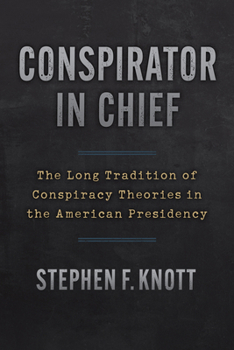Conspirator in Chief: The Long Tradition of Conspiracy Theories in the American Presidency
Esteemed presidential historian Stephen F. Knott takes readers on a sobering tour of the lowlights in the American presidency, showing how presidents from Thomas Jefferson to Donald Trump have engaged in reckless conspiracy-mongering about their political opponents in an effort to increase their power and privilege.
Today we are inundated with conspiracy theories--QAnon, the "Big Lie," Pizzagate, the Epstein Files, and innumerable false claims about vaccines and other medicines. But the widespread proliferation of lies and misinformation can make it easy to forget that conspiracy theories have been part of American life from the beginning. The land of the free and the home of the brave has also been the den of false rumors and conspiratorial claims about one's political enemies--not merely by rank-and-file Americans but also by our most powerful and consequential elected leaders. As political historian Stephen F. Knott recounts in painful detail, the Commander in Chief of the United States has often acted as Conspirator in Chief.
Part presidential history and part descent into a political Dante's Inferno, Conspirator in Chief is a tour through the Hall of Shame in American politics. Thomas Jefferson used surrogates to spread false claims about Alexander Hamilton in order to destroy his political influence, attacked newspaper editors who were critical of his party and policies, and used conspiracy theories about the Federalists to tarnish them in the eyes of the American people. This brand of demagoguery reached an apex in the presidency of Andrew Jackson, who publicly defamed abolitionists, manipulated newspapers to publish his conspiracies, and spread his own "Big Lie" about the 1824 election being stolen from him in a "corrupt bargain." Andrew Johnson spread false accusations about the Radical Republicans and he declared the need for "white emancipation" and made spurious claims about the dangers of a coming Black supremacy as a result of Reconstruction. Woodrow Wilson, according to Knott, continued Johnson's racist and conspiratorial interpretation of American history.
In addition to our most infamous presidents, Knott uncovers the surprising conspiratorial inclinations of our more esteemed leaders, including Franklin Delano Roosevelt and Harry S Truman. Knott shows how both presidents painted their opponents in an extreme light, casting aspersions on political rivals by calling them "betrayers of America," "spies, saboteurs, and traitors," and comparing them to Nazis, fascists, and communists. Less surprising are the presidencies of Richard Nixon and Donald J. Trump, both known for their propagation of racist and paranoid beliefs and their denigration of political opponents. As Knott demonstrates in excruciating detail, Trump epitomizes the worst of this long American tradition. While Trump is in a league of his own regarding the sheer output and outlandishness of his conspiracy-mongering, he did not begin this odious practice.
In this follow-up to The Lost Soul of the American Presidency, Knott does more than show how low American presidents have gone. He also illuminates an alternative track record in which presidents took the high road and embraced the "better angels of our nature." Conspirator in Chief is a sobering reminder of the power of a president's words and the damage they can do when that power is wielded in self-serving ways, but it is also a reminder that words can heal and repair as well. Knott calls the nation to a more humane and dignified future.





